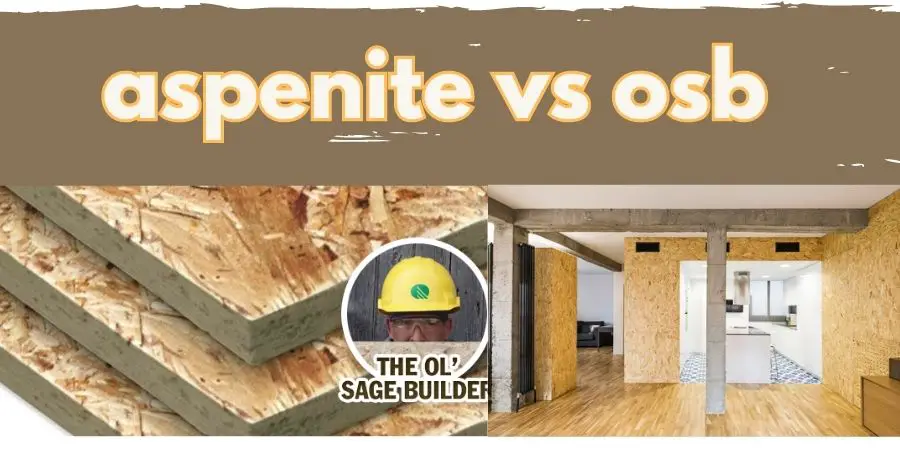If you’re planning to embark on a new DIY project that requires sheathing or decking, you might be wondering whether to use aspenite or oriented strand board (OSB).
Both materials are popular options for construction, but they have different characteristics and uses. In this blog post, we’ll compare aspenite and OSB and help you choose the best one for your project.

Table of Contents
What is Aspenite?
Aspenite is a type of composite wood panel made from wood chips and adhesives. It’s also known as chipboard or particleboard.
Aspenite is a versatile material that is commonly used for furniture, cabinets, flooring, and subfloors. It’s also used for wall sheathing, roof decking, and other construction applications.
What is OSB?
OSB is another type of composite wood panel made from wood chips and adhesives.
However, unlike aspenite, which uses whole wood chips, OSB uses wood strands that are arranged in layers and oriented in different directions.
This creates a strong and durable panel that is resistant to bending and warping. OSB is commonly used for subfloors, roof decking, and wall sheathing in construction.
Aspenite vs. OSB: The Differences
Strength and Durability
One of the most significant differences between aspenite and OSB is their strength and durability.
OSB is stronger and more durable than aspenite because of its unique orientation of wood strands.
It has higher load-bearing capacity and is more resistant to bending and warping than aspenite.
Moisture Resistance
Another significant difference between aspenite and OSB is their moisture resistance.
Aspenite is more susceptible to moisture damage than OSB. If exposed to moisture, it can swell and warp, leading to structural damage.
On the other hand, OSB has higher moisture resistance due to its resin binders, which make it more suitable for exterior applications.
Price
Price is another factor to consider when choosing between aspenite and OSB.
Aspenite is generally cheaper than OSB, making it a more cost-effective option for budget-conscious DIYers.
Ease of Installation
Both aspenite and OSB are relatively easy to install, but there are some differences to consider.
Aspenite is lighter and easier to handle than OSB, but it’s also more fragile and can be prone to chipping and breaking during installation.
On the other hand, OSB is heavier and more difficult to handle, but it’s also sturdier and less prone to damage during installation.
Which One Should You Choose?
Now that you know the differences between aspenite and OSB, you might be wondering which one to choose for your DIY project. Here are some factors to consider:
- If you’re on a tight budget, aspenite might be a better option due to its lower price.
- If you’re planning to use the material for exterior applications, such as roof decking or wall sheathing, OSB might be a better option due to its higher moisture resistance.
- If you’re looking for a stronger and more durable material that can withstand heavy loads and bending, OSB is a better option.
Conclusion
Aspenite and OSB are both composite wood panels that are commonly used in construction and DIY projects. While aspenite is cheaper and lighter, OSB is stronger and more durable, with higher moisture resistance. Consider your project requirements and budget when choosing between the two materials.
FAQs
What is the difference between aspenite and OSB?
Aspenite is a type of composite wood panel made from wood chips and adhesives, while OSB is also a composite wood panel made from wood chips and adhesives, but the wood strands are oriented in different directions to create a stronger and more durable panel.
Which one is stronger, aspenite or OSB?
OSB is stronger than aspenite due to its unique orientation of wood strands, which gives it higher load-bearing capacity and resistance to bending and warping.
Which one is better for exterior applications, aspenite or OSB?
OSB is better for exterior applications, such as roof decking or wall sheathing, because it has higher moisture resistance due to its resin binders.
Which one is cheaper, aspenite or OSB?
Aspenite is generally cheaper than OSB, making it a more cost-effective option for budget-conscious DIYers.
Can aspenite and OSB be used interchangeably?
While both materials can be used for similar applications, it’s important to consider their different characteristics and uses before choosing which one to use for your project. OSB is generally a better option for heavier loads and exterior applications, while aspenite is better suited for lighter loads and interior applications.
Is there a difference in installation between aspenite and OSB?
Aspenite is lighter and easier to handle than OSB, but it can also be more fragile and prone to chipping and breaking during installation. On the other hand, OSB is heavier and more difficult to handle, but it’s also sturdier and less prone to damage during installation.





